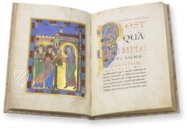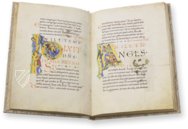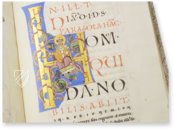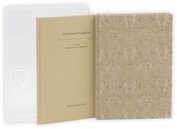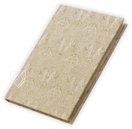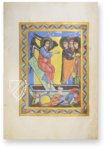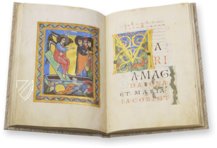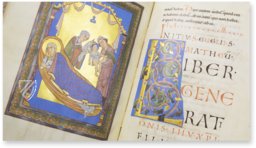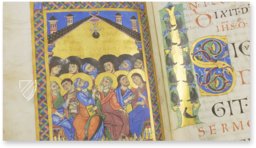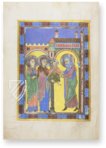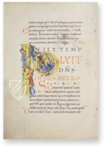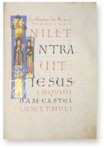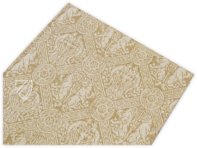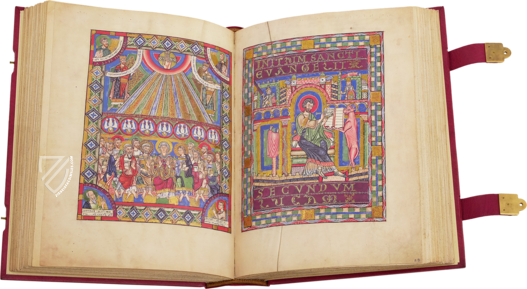Passau Evangeliary
(3,000€ - 7,000€)
The richly illustrated Passau Evangeliary originated ca. 1170–80 in the Augustinian Canon Monastery of St. Nikola at the convergence of three rivers in Passau. It contains text excerpts from the Gospels of the New Testament for readings on Sundays and holidays during the church year. 49 fantastic historiated initials and eight intensely colored full-page miniatures make the Romanesque manuscript a special testimonial to the artistry of the scriptoria in Passau. While the eye of the beholder is delighted by the historiated initials with small figures, animals, or artful tendrils, it is the Byzantine stylistic elements of the glimmering miniatures by two participating illuminators that make it interesting.
Passau Evangeliary
An especially beautiful Romanesque illuminated manuscript originates from Passau, the famous city of three rivers, ca. 1170–80 in the Augustinian Canon Monastery of St. Nikola. Readings for Sundays and holidays during the church year are compiled in the Passau Evangelary, which originate from the Gospels. 49 large historiated initials as well as 8 full-page miniatures are found on 44 pages measuring 32.5 x 22.5 cm. Consequently, color-intensive pictures on nearly every page invite the beholder to immerse themselves in the biblical stories. Today, the medieval manuscript is an authentic testimonial to the artistry and deep faith of a bygone epoch.
Radiant Initials
The numerous radiant golden initials on a colored background are so richly and fantastically embellished with small animals, flowers, figures, or artful tendrils, they appear like individual miniatures. The historiated initials are particularly interesting, in which the figures illustrate the text of the Gospels concretely, or which have a church holiday as a theme. On the other hand, the adornment simply serves to delight the eye of the beholder.
Byzantine Stylistic Elements in Romanesque Illumination
Two illuminators altogether participated in the manufacture of the evangeliary, who were named after their primary miniatures. The Petrus Master and the Ecclesia Master created the miniatures in layers. Both of them demonstrated the plastic design of body and garment characteristic of Romanesque illumination. Thus, the fabric is not merely a rigid shell, but is fleshed out in such a way that it lies softly upon the figures and allows individual body parts to protrude. Garment folds additionally emphasize the body volume. Byzantine stylistic elements came to Salzburg in the southern German-speaking regions and were also precipitated in the Passau Evangelary. The extensively invested gold backgrounds and the design of the faces as well as the flesh tones are typical. The noses are mostly long and have an overhanging tip. The fixed gaze and the altogether stern expression of the figures are equally compelled by the Byzantine face shapes. The vigorous modelling of the faces with olive-green shadows, white heightening, and red spots exhibits their particular similarity with the depiction of Byzantine saints.
Passau Illumination as a Rarity
Scriptoria in Passau produced numerous precious manuscript in the 12th century that were highly prized by secular princes and princes of the church alike. The once rich tradition was almost completely extinguished over the course of the centuries by fires and earthquakes. The Passau Evangelary is almost the only surviving testimonial to the artistically superior and unique illumination of Passau during the Romanesque period, and so its worth can hardly be overestimated.
Codicology
- Alternative Titles
- Gospel of Passau
Pericope Book of Passau
Passauer Evangelistar
L’Évangéliaire de Passau - Size / Format
- 88 pages / 32.5 × 22.5 cm
- Origin
- Germany
- Date
- Ca. 1170–1180
- Epochs
- Style
- Language
- Illustrations
- 8 magnificent full-page miniatures, 49 often historiated ornamental initials, and opulent gold decoration throughout the work
- Content
- Text passages (pericopes) of the Gospels for the lectures on Sundays and holidays in the chronological order of the church year
- Artist / School
- Master of Ecclesia and Master of St Peter
Influenced by the Romanesque and Byzantine styles
Passau Evangeliary
Presentation in the Temple
Gold and silver dominate the scene in this extraordinary Romanesque miniature: the Virgin Mary presents Jesus to Simeon, the high priest, while the prophetess Hannah holds a basket of doves, a common sight in such scenes and an allusion to the Holy Spirit. Gold and silver leaf feature prominently in the scene and are used to contrast one another. The figures stand under an arched architecture among speckled columns – the artist’s attempt to replicate marble.

Passau Evangeliary
The Last Supper
This Romanesque masterpiece is a testimonial to the scriptorium in Passau from which it came and to the ongoing influence of Byzantine art, especially in the Holy Roman Empire. The gold/green frame has a wonderful leaf pattern rendered in light blue and pink, save for the lower left corner which is painted green, and the scene is additionally framed by classical architecture.
The miniature is dominated by gold leaf, especially the Byzantine-style burnished gold background, which is alternated with silver in the halos. Expressive faces with long, curved noses, piercing eyes, and strong gestures are also distinctly Byzantine. Judas is pictured apart from the rest of the 12 Apostles and as he opens his mouth to receive the Eucharist, an evil spirit slips in.
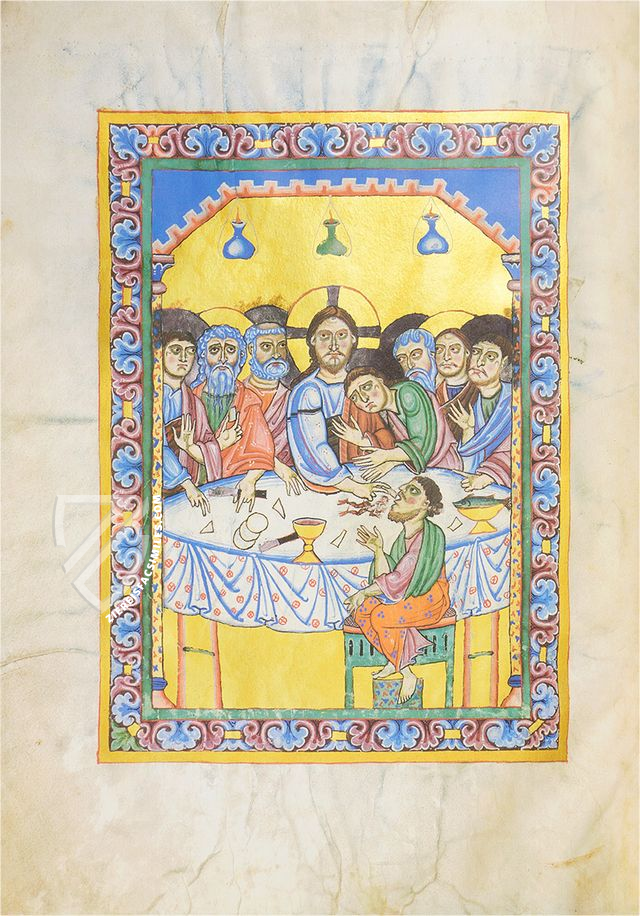
#1 Das Passauer Evangelistar
Language: German
(3,000€ - 7,000€)
- Treatises / Secular Books
- Apocalypses / Beatus
- Astronomy / Astrology
- Bestiaries
- Bibles / Gospels
- Chronicles / History / Law
- Geography / Maps
- Saints' Lives
- Islam / Oriental
- Judaism / Hebrew
- Single Leaf Collections
- Leonardo da Vinci
- Literature / Poetry
- Liturgical Manuscripts
- Medicine / Botany / Alchemy
- Music
- Mythology / Prophecies
- Psalters
- Other Religious Books
- Games / Hunting
- Private Devotion Books
- Other Genres
- Afghanistan
- Armenia
- Austria
- Belgium
- Colombia
- Croatia
- Cyprus
- Czech Republic
- Denmark
- Egypt
- Ethiopia
- France
- Germany
- Greece
- Hungary
- India
- Iran
- Iraq
- Israel
- Italy
- Japan
- Lebanon
- Luxembourg
- Mexico
- Morocco
- Netherlands
- Palestine
- Peru
- Poland
- Portugal
- Russia
- Serbia
- Spain
- Sri Lanka
- Sweden
- Switzerland
- Syria
- Turkey
- Ukraine
- United Kingdom
- United States
- Uzbekistan
- Aboca Museum
- Ajuntament de Valencia
- Akademie Verlag
- Akademische Druck- u. Verlagsanstalt (ADEVA)
- Aldo Ausilio Editore - Bottega d’Erasmo
- Alecto Historical Editions
- Alkuin Verlag
- Almqvist & Wiksell
- Amilcare Pizzi
- Andreas & Andreas Verlagsbuchhandlung
- Archa 90
- Archiv Verlag
- Archivi Edizioni
- Arnold Verlag
- ARS
- Ars Magna
- ArtCodex
- AyN Ediciones
- Azimuth Editions
- Badenia Verlag
- Bärenreiter-Verlag
- Belser Verlag
- Belser Verlag / WK Wertkontor
- Benziger Verlag
- Bernardinum Wydawnictwo
- BiblioGemma
- Biblioteca Apostolica Vaticana (Vaticanstadt, Vaticanstadt)
- Bibliotheca Palatina Faksimile Verlag
- Bibliotheca Rara
- Boydell & Brewer
- Bramante Edizioni
- Bredius Genootschap
- Brepols Publishers
- British Library
- C. Weckesser
- Caixa Catalunya
- Canesi
- CAPSA, Ars Scriptoria
- Caratzas Brothers, Publishers
- Carus Verlag
- Casamassima Libri
- Chavane Verlag
- Christian Brandstätter Verlag
- Circulo Cientifico
- Club Bibliófilo Versol
- Club du Livre
- CM Editores
- Collegium Graphicum
- Collezione Apocrifa Da Vinci
- Comissão Nacional para as Comemorações dos Descobrimentos Portugueses
- Coron Verlag
- Corvina
- CTHS
- D. S. Brewer
- Damon
- De Agostini/UTET
- De Nederlandsche Boekhandel
- De Schutter
- Deuschle & Stemmle
- Deutscher Verlag für Kunstwissenschaft
- DIAMM
- Droz
- E. Schreiber Graphische Kunstanstalten
- Ediciones Boreal
- Ediciones Grial
- Ediclube
- Edições Inapa
- Edilan
- Editalia
- Edition Deuschle
- Edition Georg Popp
- Edition Leipzig
- Edition Libri Illustri
- Editiones Reales Sitios S. L.
- Éditions de l'Oiseau Lyre
- Editions Medicina Rara
- Editorial Casariego
- Editorial Mintzoa
- Editrice Antenore
- Editrice Velar
- Edizioni Edison
- Egeria, S.L.
- Eikon Editores
- Electa
- Emery Walker Limited
- Enciclopèdia Catalana
- Eos-Verlag
- Ephesus Publishing
- Ernst Battenberg
- Eugrammia Press
- Extraordinary Editions
- Fackelverlag
- Facsimila Art & Edition
- Facsimile Editions Ltd.
- Facsimilia Art & Edition Ebert KG
- Faksimile Verlag
- Feuermann Verlag
- Folger Shakespeare Library
- Franco Cosimo Panini Editore
- Friedrich Wittig Verlag
- Fundación Hullera Vasco-Leonesa
- G. Braziller
- Gabriele Mazzotta Editore
- Gebr. Mann Verlag
- Gesellschaft für graphische Industrie
- Getty Research Institute
- Giovanni Domenico de Rossi
- Giunti Editore
- Graffiti
- Grafica European Center of Fine Arts
- Guido Pressler
- Guillermo Blazquez
- Gustav Kiepenheuer
- H. N. Abrams
- Harrassowitz
- Helikon
- Hendrickson Publishers
- Henning Oppermann
- Herder Verlag
- Hes & De Graaf Publishers
- Hoepli
- Holbein-Verlag
- Hortus Deliciarum
- Houghton Library
- Hugo Schmidt Verlag
- Idion Verlag
- Il Bulino, edizioni d'arte
- ILte
- Imago
- Insel Verlag
- Instituto Nacional de Antropología e Historia
- Istituto dell'Enciclopedia Italiana - Treccani
- Istituto Ellenico di Studi Bizantini e Postbizantini
- Istituto Geografico De Agostini
- Istituto Poligrafico e Zecca dello Stato
- Italarte Art Establishments
- J. Thorbecke
- Jan Thorbecke Verlag
- Johnson Reprint Corporation
- Josef Stocker
- Josef Stocker-Schmid
- Jugoslavija
- Karl W. Hiersemann
- Kasper Straube
- Kaydeda Ediciones
- Kindler Verlag / Coron Verlag
- Kodansha International Ltd.
- Konrad Kölbl Verlag
- Kurt Wolff Verlag
- La Liberia dello Stato
- La Linea Editrice
- La Meta Editore
- Lambert Schneider
- Landeskreditbank Baden-Württemberg
- Leo S. Olschki
- Les Incunables
- Library of Congress
- Libreria Musicale Italiana
- Lichtdruck
- Lito Immagine Editore
- Lumen Artis
- Lund Humphries
- M. Moleiro Editor
- Maison des Sciences de l'homme et de la société de Poitiers
- Manuscriptum
- Martinus Nijhoff
- Maruzen-Yushodo Co. Ltd.
- MASA
- McGraw-Hill
- Militos
- Millennium Liber
- Müller & Schindler
- Nahar and Steimatzky
- National Library of Wales
- Neri Pozza
- Nova Charta
- Oceanum Verlag
- Odeon
- Orbis Mediaevalis
- Orbis Pictus
- Österreichische Staatsdruckerei
- Oxford University Press
- Pageant Books
- Parzellers Buchverlag
- Patrimonio Ediciones
- Pattloch Verlag
- PIAF
- Pieper Verlag
- Plon-Nourrit et cie
- Prestel Verlag
- Princeton University Press
- Prisma Verlag
- Priuli & Verlucca, editori
- Pro Sport Verlag
- Propyläen Verlag
- Pytheas Books
- Quaternio Verlag Luzern
- Reales Sitios
- Recht-Verlag
- Reichert Verlag
- Reichsdruckerei
- Riehn & Reusch
- Roberto Vattori Editore
- Rosenkilde and Bagger
- Roxburghe Club
- Salerno Editrice
- Sarajevo Svjetlost
- Schöck ArtPrint Kft.
- Scolar Press
- Scrinium
- Scripta Maneant
- Scriptorium
- Siloé, arte y bibliofilia
- SISMEL - Edizioni del Galluzzo
- Sociedad Mexicana de Antropología
- Société des Bibliophiles & Iconophiles de Belgique
- Soncin Publishing
- Sorli Ediciones
- Stainer and Bell
- Studer
- Styria Verlag
- Sumptibus Pragopress
- Szegedi Tudomànyegyetem
- Taberna Libraria
- Tarshish Books
- Taschen
- Tempus Libri
- Testimonio Compañía Editorial
- Thames and Hudson
- The Clear Vue Publishing Partnership Limited
- The Facsimile Codex
- The Folio Society
- The Marquess of Normanby
- The Richard III and Yorkist History Trust
- Tip.Le.Co
- TouchArt
- TREC Publishing House
- TRI Publishing Co.
- Trident Editore
- Typis Regiae Officinae Polygraphicae
- Union Verlag Berlin
- Universidad de Granada
- University of California Press
- University of Chicago Press
- Urs Graf
- Vallecchi
- Van Wijnen
- VCH, Acta Humaniora
- VDI Verlag
- VEB Deutscher Verlag für Musik
- Verlag Anton Pustet / Andreas Verlag
- Verlag Bibliophile Drucke Josef Stocker
- Verlag der Münchner Drucke
- Verlag für Regionalgeschichte
- Verlag Styria
- Vicent Garcia Editores
- W. Turnowsky
- Waanders Printers
- Wiener Mechitharisten-Congregation (Wien, Österreich)
- Wissenschaftliche Buchgesellschaft
- Wydawnictwo Dolnoslaskie
- Xuntanza Editorial
- Zakład Narodowy
- Zollikofer AG




